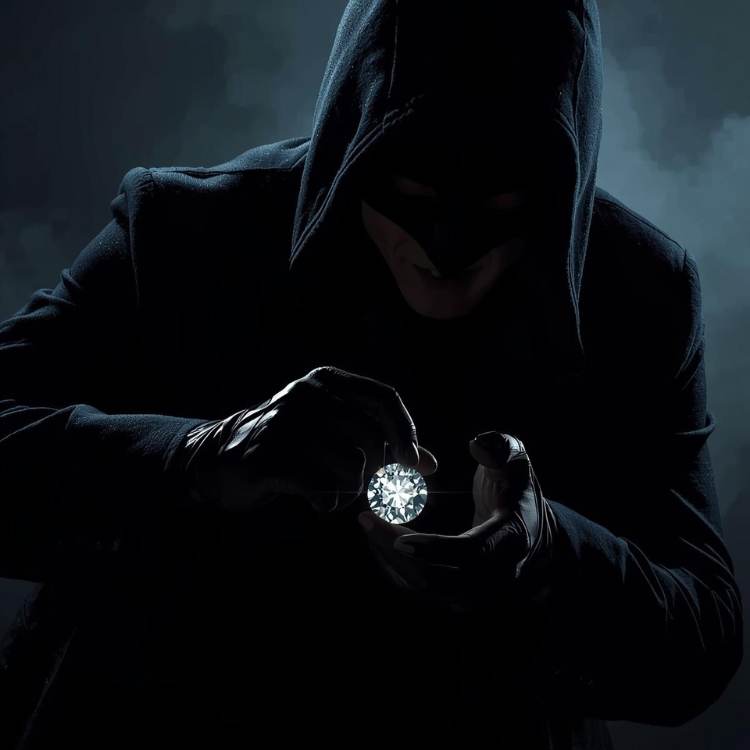
The “Pink Panthers” 💎 – An International Network of Jewel Thieves in the 21st Century
Few names in modern criminal history evoke such fascination — or admiration — as the “Pink Panthers”.
This international network of jewel thieves, often described as the most successful and elusive gang of the 21st century, has pulled off hundreds of high-profile heists across the globe. From Tokyo to Dubai, Paris to Geneva, their robberies have stunned law enforcement and captivated the public imagination.
The Pink Panthers are not movie villains — though their name was inspired by one. They are real criminals, responsible for some of the boldest and most theatrical jewel thefts ever recorded, with stolen goods worth hundreds of millions of dollars.
But who are they really? How did they operate with such precision and coordination? And why has it been so difficult to bring them to justice?
Let’s dive into the real story behind the Pink Panthers — a tale of diamonds, danger, and deception. 💎🕵️♀️
💥 Who Are the Pink Panthers?
The Pink Panthers are not a single gang, but rather a loose network of hundreds of thieves, smugglers, and fences (dealers who sell stolen goods).
Most members are believed to be from the Balkans — primarily Serbia, Montenegro, Bosnia, and Croatia — men and women who came of age during or after the Yugoslav Wars of the 1990s.
Many had military experience, giving them the skills, discipline, and cold precision seen in their operations. Experts believe the Panthers consist of 30 to 40 core members, supported by dozens of collaborators who help with logistics, disguises, getaways, and the sale of stolen jewels.
Their heists are famous for their speed, sophistication, and theatricality — a mix of military strategy and cinematic flair.
🎬 The Origin of Their Name
The nickname “Pink Panthers” was coined by Interpol, the international police organization, after a heist in London in 2003.
During that robbery, police recovered a diamond hidden inside a jar of face cream — just like in the classic 1975 comedy film “The Return of the Pink Panther.”
The name stuck. It captured the group’s audacity, humor, and glamour — blending the charm of Hollywood with the ruthlessness of real-life crime.
Since then, the Pink Panthers have become the stuff of legend, blending fact and fiction in a way few criminal groups ever have.
💎 Their Most Daring Heists
Over the past two decades, the Pink Panthers have been linked to over 300 robberies across more than 35 countries, with total losses estimated at over $500 million.
Here are some of their most famous heists — each one a masterpiece of planning and execution.
🕶️ 1. The London Robbery (2003)
This is the theft that gave the gang its name.
Two well-dressed men entered the Graff jewelry store in London’s upmarket Mayfair district. In less than three minutes, they stole $30 million worth of diamonds — the largest jewel theft in British history at the time.
Their calmness and precision stunned witnesses. When police later found a diamond hidden in a jar of face cream in one suspect’s apartment, Interpol dubbed them the “Pink Panthers.”
🚗 2. The Dubai Mall Smash-and-Grab (2007)
In this spectacular heist, the thieves drove two Audi sedans straight through the glass doors of the Wafi Mall in Dubai.
Wearing masks and armed with sledgehammers, they smashed display cases and stole jewels worth $3.4 million in less than 90 seconds.
They then escaped the same way they came — through the front entrance, before police could even react.
The entire event was captured on surveillance cameras, showing their military-level coordination and flawless timing.
🏝️ 3. The Monte Carlo Robbery (2008)
The luxurious Harry Winston jewelry store in Monte Carlo became another of their high-profile targets.
Disguised as wealthy women wearing wigs and makeup, several gang members entered the store just before closing time. They drew guns and ordered staff to hand over the jewels.
In under ten minutes, they walked away with an estimated $100 million in diamonds and luxury watches — one of the most expensive heists in European history.
🗼 4. The Paris Robbery (2008)
Later that same year, the Pink Panthers struck again — this time in Paris, at another Harry Winston boutique.
This robbery was so bold that it felt almost theatrical: four armed men, two of them dressed as women, entered the shop and calmly looted its showcases.
They called employees by name, suggesting insider information, and made off with $108 million in jewelry — an almost unbelievable sum.
To this day, much of the stolen treasure has never been recovered. 💰
⚙️ How They Operated: The Art of the Perfect Heist
The Pink Panthers weren’t common criminals. Their robberies were carefully choreographed — sometimes planned for months, even years.
Their signature style combined military tactics, speed, and simplicity.
Here’s how they typically worked:
- Extensive Surveillance 🔍
Before any heist, they studied the target in detail — analyzing security systems, employee routines, escape routes, and police response times. - Flawless Disguises 🎭
They often disguised themselves as tourists, businesspeople, or even women. In some cases, they used professional makeup artists to alter their appearance. - Fast, Precise Execution ⚡
Most of their robberies lasted under three minutes. Every second was planned. - Clean Getaways 🚙
Getaway cars were often stolen in advance and abandoned minutes after the robbery. In some cases, they escaped by boat, motorcycle, or even blending into crowds. - No Violence (Usually) 🕊️
While armed, the Pink Panthers were known for avoiding unnecessary violence. They relied on intimidation, not bloodshed. - Global Coordination 🌍
Their network extended across continents. After major heists, the stolen jewels were broken up and smuggled through complex routes involving Switzerland, Dubai, and the Balkans.
Their professionalism led Interpol to describe them as “one of the most efficient criminal networks in history.”
🧩 Who Were the Members?
The Pink Panthers were not an official organization with leaders and soldiers.
Instead, criminologists describe them as a “franchise” — independent crews connected by family, friendship, and wartime bonds, who sometimes collaborated or shared contacts.
Many came from former Yugoslavia, a region deeply scarred by the wars of the 1990s. These conflicts produced a generation of men skilled in weapons, logistics, and survival.
When peace returned, some turned those same skills toward a different kind of battlefield: the global luxury market.
Interpol has identified over 800 individuals suspected of being linked to the Pink Panthers network. However, only a fraction have been caught — and fewer still convicted.
🕵️♂️ The Global Manhunt
Since 2003, Interpol has led a massive international effort to track the Pink Panthers.
Operation “Panther” has connected law enforcement agencies in over 25 countries, sharing intelligence and coordinating arrests.
Despite these efforts, the gang remains remarkably resilient. Many members have been arrested and escaped — sometimes in spectacular ways.
🚨 The Swiss Prison Escape (2009)
Two Panthers escaped from a Swiss prison when armed men rammed the gates with a car and opened fire, allowing them to flee.
🚨 The French Escape (2013)
In another daring incident, a gang member escaped from a prison in Switzerland using explosives and a ladder. He was later captured — but his story added to the Panthers’ legend.
Each escape reinforced their image as “gentleman thieves” — clever, daring, and unstoppable.
📺 Media, Myths, and Pop Culture
The Pink Panthers’ legend has been fueled by the media, which portrays them as modern-day Robin Hoods — sophisticated criminals who steal from the rich without harming the innocent.
They’ve been the subject of:
- 🎞️ Documentaries, such as “Smash & Grab: The Story of the Pink Panthers” (2013), which includes interviews with actual members.
- 📚 Books, exploring their links to the Balkan wars and organized crime.
- 📰 News features describing them as “the most successful jewel thieves in history.”
Their cinematic methods — disguises, fast cars, clever getaways — make them seem like characters straight out of a Hollywood thriller.
But behind the glamour lies a darker reality: their crimes destroyed livelihoods, traumatized victims, and financed illegal networks linked to arms and drug trafficking.
💰 The Economic Impact of the Heists
The Pink Panthers’ activities have had a massive impact on the global jewelry industry.
Luxury brands like Cartier, Harry Winston, and Graff have spent millions on upgrading security systems. Jewelers worldwide have reinforced display cases, installed facial recognition cameras, and trained staff for armed robbery scenarios.
Insurance companies have raised premiums dramatically for high-end jewelers — all because of the fear of another Panther-style attack.
⚖️ Justice and Legacy
Over the years, dozens of members have been captured — in Spain, France, Italy, Switzerland, and Japan.
Yet the full network has never been dismantled. Experts believe some remain active today, planning smaller, more discreet robberies or working in other criminal enterprises.
Interpol still lists several suspected members on its most-wanted list. But the myth of the Pink Panthers has outlived the arrests.
Their story endures because it reflects something deeper about human nature: the fascination with clever criminals, the seduction of luxury, and the thin line between charm and crime.
🧠 What Made Them So Successful?
Criminologists point to several key factors:
- Military discipline and coordination
- Detailed preparation
- Non-violent tactics, which kept public sympathy
- Strong regional ties, based on loyalty and trust
- Global reach, using international smuggling routes
In short, they combined brains, speed, and style — a rare trio in the world of organized crime.
🕰️ Conclusion: Between Legend and Reality
The story of the Pink Panthers is one of paradox — ruthless thieves with elegance, criminals who became cultural icons.
They embody the tension between law and glamour, morality and greed, and the eternal human fascination with the perfect crime.
A century after Vincenzo Peruggia stole the Mona Lisa, the Pink Panthers redefined what a jewel heist could be in the modern world — fast, global, and cinematic.
And while their jewels may glitter, their legacy reminds us that no amount of brilliance can hide the darkness of crime. 💎🚨
📚 Sources
- Interpol Reports, Operation Panther, 2003–2023.
- BBC News, “Inside the Pink Panthers: The World’s Most Successful Jewel Thieves” (2022).
- The Guardian, “The Real-Life Pink Panthers” (2013).
- Vanity Fair, “The Gentleman Thieves Who Terrorized the Luxury World” (2019).
- Smash & Grab: The Story of the Pink Panthers, Documentary, 2013.

